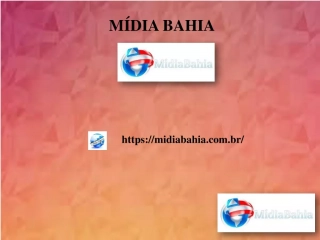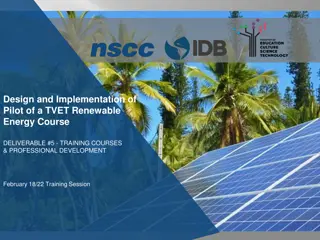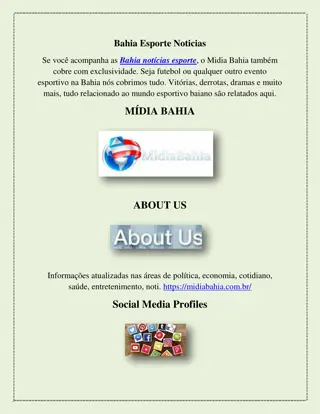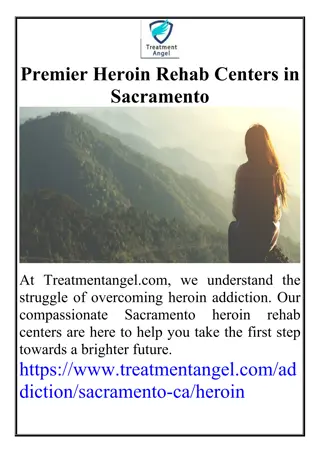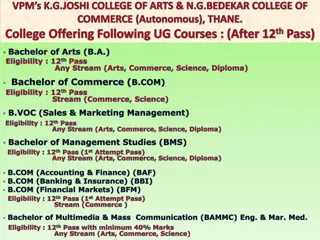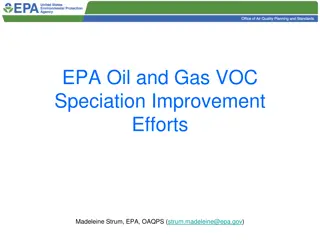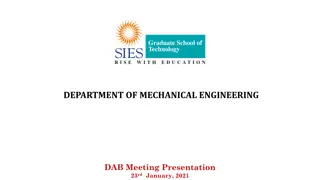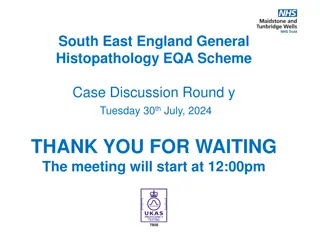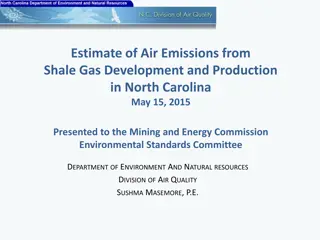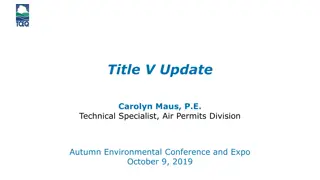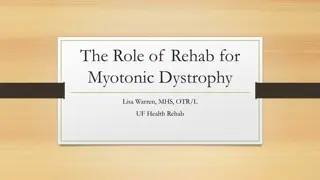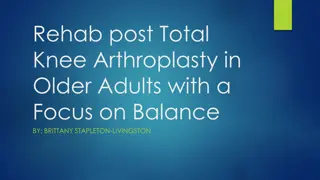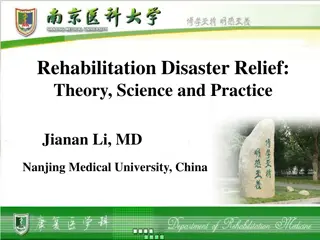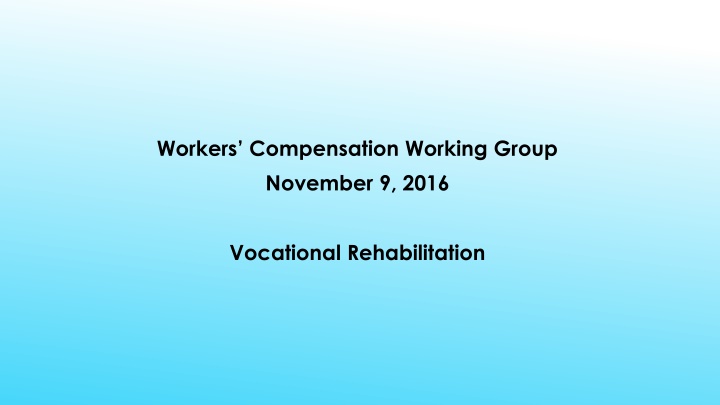
Vocational Rehabilitation Program Process Overview
Explore the step-by-step process of vocational rehabilitation, including enrollment, selection of a counselor, employer involvement, and approval phases. Learn about rights, responsibilities, limitations, objections, reports, and plan revisions within the program.
Download Presentation

Please find below an Image/Link to download the presentation.
The content on the website is provided AS IS for your information and personal use only. It may not be sold, licensed, or shared on other websites without obtaining consent from the author. If you encounter any issues during the download, it is possible that the publisher has removed the file from their server.
You are allowed to download the files provided on this website for personal or commercial use, subject to the condition that they are used lawfully. All files are the property of their respective owners.
The content on the website is provided AS IS for your information and personal use only. It may not be sold, licensed, or shared on other websites without obtaining consent from the author.
E N D
Presentation Transcript
Workers Compensation Working Group November 9, 2016 Vocational Rehabilitation
Employer Claimant Wants claimant to return to employer s workplace Wants to return to work for employer in any capacity Works with both claimant and employer so claimant may RTW VR Counselor VOCATIONAL REHABILITATION IDEAL SITUATION
Employer Claimant Hesitant to have claimant RTW with a permanent disability Hesitant to RTW for employer with injury limitations Limitations with having employer and claimant hesitant about RTW VR Counselor VOCATIONAL REHABILITATION - LIMITATIONS
Day 157 After enrollment through selection form, Claimant is entitled to VR-TTD HRS 386-25(k) HAR 12-14-38(a) Day 157 Day 120 Day 150 VR counselor submits employee selection form HAR 12-14-23(d) Day 0 DOI Employer provides VR information to Claimant HAR 12-14-23(c) Claimant selects VR counselor HAR 12-14-23(c) Prior to approved VR plan, VR counselor required to submit progress reports every 30 days to Employer HAR 12-14-4.1 Day 232 (approx.) VR counselor submits VR plan HRS 386-25(e) (no deadline for submitting VR plan) Day 202 (approx.) VR counselor submits an initial evaluation report HRS 386-25(d) Day 167 Through VR unit, Employer may object to Claimant s VR eligibility HAR 12-14-23(e) Day 242 (approx.) Employer may object to VR plan HAR 12-14-10(a) After approved VR plan, VR counselor required to submit status reports every 30 days to Employer HAR 12-14-27 Day 254 (approx.) VR plan automatically approved if no action taken by the Director HAR 12-14-10(c) Director may modify, suspend or terminate a VR plan HAR 12-14-9 Maximum of one revision to a VR plan is allowed HAR 12-14-7 VR plan ends HAR 12-14-6 VR-TTD ends HRS 386-25(k) CURRENT PROCESS FOR VOC. REHAB. PLANS
After enrollment through employee selection form, Claimant is entitled to VR-TTD HRS 386-25(k) HAR 12-14-38(a) VR counselor submits employee selection form HAR 12-14-23(d) EMPLOYEE SELECTION OF VR COUNSELOR DOES NOT AUTOMATICALLY ENROLL CLAIMANT IN VR
A copy of the completed enrollment form and statement of worker s rights and responsibilities shall be sent together with the initial evaluation to the employee, the director, and the employer . (underline added) -- See, 12-14-35 (2), HAR ENROLLMENT REQUIREMENT IN REHABILITATION PROGRAM
Day 157 Prior to approved VR plan, VR counselor required to submit progress reports every 30 days to Employer HAR 12-14-4.1 Day 167 Day 232 (approx.) VR counselor submits VR plan HRS 386-25(e) After enrollment through employee selection form, Claimant is entitled to VR-TTD HRS 386-25(k) HAR 12-14-38(a) Through VR unit, Employer may object to Claimant s VR eligibility HAR 12-14-23(e) After approved VR plan, VR counselor required to submit status reports every 30 days to Employer HAR 12-14-27 Day 254 (approx.) VR plan automatically approved if no action taken by the Director HAR 12-14-10(c) Maximum of one revision to a VR plan is allowed HAR 12-14-7 Day 242 (approx.) Employer may object to VR plan HAR 12-14-10(a) VR plan ends HAR 12-14-6 Director may modify, suspend or terminate a VR plan HAR 12-14-9 VR-TTD ends HRS 386-25(k) ENROLLMENT BEGINS VR-TTD, PROGRESS REPORTING, PLAN SUBMITTAL AND SUBSEQUENT ACTIONS
VR ELIGIBILITY REQUIREMENTS 1. Have or may have suffered permanent disability as a result of a work injury; and 2. Vocational rehabilitation is feasible -- See, HRS 386-25 Vocational rehabilitation STATUTE DOESN T REQUIRE PERMANENT DISABILITY AS LONG AS FEASIBLE
Step 1 Can claimant return to same job as suitable gainful employment?; if not, Step 2 Can claimant return to same employer as suitable gainful employment ?; if not, Step 3 Can claimant work for a different employer as suitable gainful employment ?; if not, Step 4 Providing training to obtain employment in another occupational field. -- HRS 386-25(e) THE VR PLAN MUST INCLUDE A STATEMENT OF THE FEASIBILITY OF THE VOCATIONAL GOAL...
- HRS 386-1 Definitions. Suitable gainful employment means employment or self-employment within the geographical area where the employee resides, which is reasonably attainable and which offers an opportunity to restore the employee s earnings capacity at the time of injury and to return the employee to the active labor force as quickly as possible in a cost-effective manner, giving due consideration to the employee s qualifications, interests, incentives, future earnings capacity, and the present and future labor market. (underline added) THE DEFINITION OF SUITABLE GAINFUL EMPLOYMENT PROVIDES FOR 100% OF PRE-INJURY EARNINGS CAPACITY AND OPTION OF SELF- EMPLOYMENT
(1) A physicians assessment of the employees physical limitations, psychological limitations, and ability to return to work. (2) A labor market survey indicating there are reasonable assurances that the proposed occupation or proposed reemployment is readily available. (3) A job analysis of the proposed occupation... (4) The nature and extent of the vocational rehabilitation services to be provided. (5) A report of tests and copies that have been administered to the injured worker. (6) If retraining is necessary, the cost of retraining. (7) The total cost of the VR plan. (8) The employee s approval of the plan. -- HRS 386-25(f) Vocational Rehabilitation. (bold added) IN ADDITION TO THE STATEMENT OF FEASIBILITY, THE VR PLAN MUST ALSO INCLUDE 8 REQUIREMENTS TO BE APPROVED
- HRS 386-1 Definitions. Suitable gainful employment means employment or self-employment within the geographical area where the employee resides, which is reasonably attainable and which offers an opportunity to restore the employee s earnings capacity at the time of injury and to return the employee to the active labor force as quickly as possible in a cost-effective manner, giving due consideration to the employee s qualifications, interests, incentives, future earnings capacity, and the present and future labor market. (underline added) AS QUICKLY AS POSSIBLE IS THE CURRENT GUIDELINE FOR THE LENGTH OF TIME TO COMPLETE A VR PLAN
- HRS 386-1 Definitions. Suitable gainful employment means employment or self-employment within the geographical area where the employee resides, which is reasonably attainable and which offers an opportunity to restore the employee s earnings capacity at the time of injury and to return the employee to the active labor force as quickly as possible in a cost-effective manner, giving due consideration to the employee s qualifications, interests, incentives, future earnings capacity, and the present and future labor market. (underline added) IN A COST-EFFECTIVE MANNER IS THE CURRENT GUIDELINE FOR THE MAXIMUM ALLOWABLE COST FOR A VR PLAN
An employee with an approved plan who is determined as able to return to usual and customary employment may choose to complete the plan or request a new plan of which the goal may be the employee s usual and customary employment. (bold and underline added) -- HRS 386-25(j) Vocational Rehabilitation EVEN IF THE EMPLOYEE CAN RETURN TO HIS/HER OLD JOB, THE APPROVED VR PLAN DOES NOT NECESSARILY END
Your Committee finds that vocational rehabilitation is a cost effective program that assists injured workers to return to the active labor force as quickly as possible. This measure as amended, promotes this program by: (1) Clarifying the responsibilities of all involved parties (i.e., DLIR, the employee, and the employer); (2) Giving injured employees the opportunity to select the provider; and (3) Encouraging injured workers and their employers to communicate clearly about these services. -- H. Stand. Comm. Rep. No. 964-98, in 1998 House Journal, at 1437 (bold added). IN 1998, THE LEGISLATURE ALLOWED CLAIMANTS TO CHOOSE THEIR OWN VR COUNSELORS INSTEAD OF THE DIRECTOR
BEFORE CHANGE: Vocational rehabilitation services for the purpose of developing a vocational rehabilitation plan shall be approved by the director and the director shall periodically review progress in each case. -- HRS 386-25(h)(1997)(bold added). AFTER CHANGE Vocational rehabilitation services for the purpose of developing a vocational rehabilitation plan may be approved by the director and the director may periodically review progress in each case. -- HRS 386-25(h)(1998)(bold added). NOTE: Currently, VR plans are automatically approved if there is no timely objection by employer or if no action is taken by the Director on an employer s timely objection. -- HAR 12-14-10(b) and (c) ALSO IN 1998, THE LEGISLATURE NO LONGER REQUIRED THE DIRECTOR TO ACTIVELY COORDINATE THE IMPLEMENTATION OF VR PLANS
Vocational Rehabilitation Plan Requirements: 1. Undefined or vague 2. Allow claimants to choose their own VR counselor 3. Automatically approve VR plans VR-TTD: 1. Before approved plan 2. Make difficult to stop, even if can return to usual and customary employment Time: 1. No deadline for submission of VR Plan 2. Undefined length of VR plan Costs: 1. Open ended cost 2. Undefined cost 3. Self-employment start up costs and no previous experience CURRENT VOCATIONAL REHABILITATION PROCESS
Iowa (26 weeks), North Dakota (104 weeks), Washington (104 weeks) Less Acute Fixed time limit for VR program Fixed cap on VR funds available to claimant West Virginia ($20K), California ($6K), Washington ($17.5K) Mississippi, Tennessee, Texas, Utah Eliminate VR and/or Workers Compensation More Acute THE LIMITING METHODS OTHER STATES USE TO MANAGE VOC. REHABILITATION COSTS
Less Acute Missouri (participation deemed necessary ); Montana (impairment > 15% or can t RTW); Minnesota (employer denied liability); Oregon (if RTW < 75% of salary from pre-injury job; Wisconsin (no VR if refuse suitable employment) Full VR benefits based on certain conditions VR benefits doled out via a hearing process THE INCENTIVE METHODS OTHER STATES USE TO MANAGE VOC. REHAB. COSTS More Acute Iowa, Michigan, Nebraska, New Hampshire, Vermont
Talk to employer to get employee back to work Less Acute Idaho Prohibit settling of VR rights Massachusetts New York (50% or greater loss of use) Mandatory VR Ohio, (Note: DHRD and C&C Hon. use informal guidelines with private VR counselors) VR counselor guidelines/ fee schedule THE RETURN TO WORK FOCUS OTHER STATES USE TO MANAGE VR COSTS (PART 1)
Reemployment Benefits Section Alaska Ohio (transitional work with same employer) Return to work program Oregon (monetary incentives for new employers) Employer-at- Injury Program North Dakota and Oregon (tax incentives) Preferred Worker Program THE RETURN TO WORK FOCUS OTHER STATES USE TO MANAGE VR COSTS (PART 2) More Acute
INCREASE ASSURANCES OF: (1) VR PROGRAM FINALITY AND (2) INJURED EMPLOYEE S RETURN TO SUITABLE GAINFUL EMPLOYMENT EMPLOYER EMPHASIS CLAIMANT EMPHASIS VR INCREASE OVERSIGHT AND ACCOUNTABILITY OF THE VR COUNSELOR INCREASE OVERSIGHT AND ACCOUNTABILITY OF THE INJURED EMPLOYEE COUNSELOR EMPHASIS 1. Return to mandatory oversight by Director 2. Start VR-TTD when VR plan is approved 3. End VR-TTD when Claimant can return to suitable gainful employment 4. Director monitors status report (annually) 5. Vouchers for training or to forego VR program (based on injury rating); case closed 6. Eligible for recompense award with PPD 1. Establish submittal timelines for labor market research (30 days) and VR plans (60 days) 2. Administrative rules for VR counselor fees (including fee schedule and tiered payment based on injured workers return to successful suitable gainful employment) 3. Provide status reports to Director (and Employer) 4. Suspend payment for non-performance 1. Time limit on length of VR plan (2 year) 2. Define successful placement (90 days employed or training completed) 3. Establish a hierarchy of employment placement options with Self employment least favored 4. Cap on maximum annual cost of VR plan (optional); declining after 2 years EMPHASIS ON INCREASE OVERSIGHT, ACCOUNTABILITY, AND FINALITY OF VR PROGRAM TO RETURN INJURED EMPLOYEE TO SUITABLE GAINFUL EMPLOYMENT
Day 30 Start the VR process sooner to keep the injured worker engaged in his/her own recovery Employer provides VR info to Claimant CLAIMANT EMPHASIS STATUTORY CHANGE NEEDED Remove delay and confusion caused by injured worker having to pick own VR counselor Day 60 GAINS FROM CLAIMANT EMPHASIS (PART 1) Director selects VR counselor STATUTORY CHANGE NEEDED Avoid delays by creating a firm deadline to submit plan Day 135 Within 30 days of initial evaluation report, VR counselor submits VR plan for approval STATUTORY CHANGE NEEDED Ensure compliance by approving plan before allowing VR-TTD Day 166 VR plan approved. After approval of VR plan, Claimant is entitled to VR-TTD STATUTORY CHANGE NEEDED
Day 180 CLAIMANT REACHES MEDICAL STABILITY VR-TTD ends Claimant eligible for 100% recompense award OR Voucher offered for training STATUTORY CHANGE NEEDED Claimant reaches medical stability within 6 months; eligible for 100% recompense award OR offered Voucher for training and VR closed CLAIMANT EMPHASIS Continued engagement by injured workers ; eligible for 80% recompense award Day 360 IF CLAIMANT RETURNS TO SUITABLE GAINFUL EMPLOYMENT THEN: VR-TTD ends and Claimant eligible for 80% of recompense award STATUTORY CHANGE NEEDED GAINS FROM CLAIMANT EMPHASIS (PART 2) Continued engagement by injured workers; justify progress at a hearing Day 365 First hearing to gauge progress of VR plan (if necessary) STATUTORY CHANGE NEEDED Day 730 (2 years) Time limit on VR Plan unless extension granted to 5 year maximum IF CLAIMANT RETURNS TO SUITABLE GAINFUL EMPLOYMENT THEN VR TTD ends and Claimant eligible for 50% of recompense award STATUTORY CHANGE NEEDED Continued engagement by injured workers
Day 60 VR counselors start sooner with injured workers (and get paid sooner) Director selects VR counselor VR STATUTORY CHANGE NEEDED COUNSELOR EMPHASIS Day 0-180 days IF CLAIMANT RETURNS TO SUITABLE GAINFUL EMPLOYMENT THEN: VR counselor receives payment based on timeframe of successfully placement; status report to Director STATUTORY CHANGE NEEDED VR counselors payment based on timely placement; Director involved in status reporting GAINS FROM VR COUNSELOR EMPHASIS 181- 730 days WHEN CLAIMANT RETURNS TO SUITABLE GAINFUL EMPLOYMENT THEN VR counselor receives payment based on timeframe Plan capped at 2 years unless approved by Director STATUTORY CHANGE NEEDED VR Plan capped at 2 years OR extended up to 5 years based on Director s decision After 730 days IF CLAIMANT RETURNS TO SUITABLE GAINFUL EMPLOYMENT THEN VR counselor receives fee based on Director decision Plan maximum 5 years STATUTORY CHANGE NEEDED
Injured employee returns to suitable gainful employment within 180 days 100% of fee Injured employee returns to suitable gainful employment within 360 days 80% of fee Injured employee returns to suitable gainful employment within 540 days 60% of fee Injured employee returns to suitable gainful employment within 730 days 50% of fee PROPOSE STATUTORY/ADMIN RULE PERCENTAGE FEE REDUCTION SYSTEM
Employer pays 100% of VR counselor invoices submitted 1st 180 days If no return to suitable gainful employment, employer pays 80% of VR counselor invoices submitted. Balance due upon return to successful suitable gainful employment 2nd 180 days If no return to suitable gainful employment, employer pays 60% of VR counselor invoices submitted. Balance due upon return to successful suitable gainful employment 3rd 180 days If no return to suitable gainful employment, employer pays 50% of VR counselor invoices submitted. Balance due upon return to successful suitable gainful employment 4th 180 days FEE SYSTEM REGULATES VR COUNSELOR FEES
Day 30 Employer provides VR information to claimant. Employer early on involvement reduces delays and keeps communication open EMPLOYER EMPHASIS STATUTORY CHANGE NEEDED Employer costs reduced when VR-TTD ends and employee is returned to suitable gainful employment. Employer offers recompense award Day 60 + IF CLAIMANT RETURNS TO SUITABLE GAINFUL EMPLOYMENT THEN: VR-TTD ends and Claimant receives recompense award STATUTORY CHANGE NEEDED GAINS FROM EMPLOYER EMPHASIS Employers will have increased certainty on staffing needs Day 730 (2 years) Time limit on VR Plan unless extension granted to a maximum of 5 years STATUTORY CHANGE NEEDED Employers will have increased certainty on labor costs CAP MAXIMUM COST OF VR PLAN STATUTORY CHANGE NEEDED

